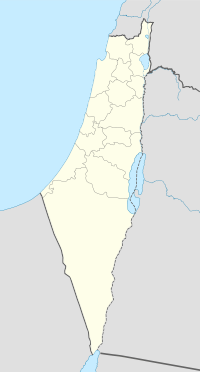Idnibba
| Idnibba | |
|---|---|
| Arabic | إدنبّة |
| Name meaning | The lower part of a valley through which water flows. |
| Also spelled | Dhenebbeh |
| Subdistrict | Ramle |
| Coordinates | 31°44′32″N 34°51′22″E / 31.74222°N 34.85611°ECoordinates: 31°44′32″N 34°51′22″E / 31.74222°N 34.85611°E |
| Palestine grid | 136/127 |
| Population | 490 (1945) |
| Area | 8,103 dunams |
| Date of depopulation | July 9–10, 1948 |
| Cause(s) of depopulation | Influence of nearby town's fall |
| Current localities | Kfar Menahem |
Idnibba (Arabic: إدنبّة) was a Palestinian village, located at latitude 31.7426937N and longitude 34.8561001,E in the southern part of the Ramle Subdistrict. It was depopulated in 1948, at which time its population was 568, and its lands are now used by Kfar Menahem.
Idnibba may have been built on the site of the Roman settlement of Danuba. The Crusaders also called it Danuba.
In 1517, the village was incorporated into the Ottoman Empire with the rest of Palestine, and in 1596 it appeared in the Ottoman tax registers being in the nahiya (subdistrict) of Gaza under the liwa' (district) of Gaza with a population of 198. It paid taxes on a number of crops, including wheat, barley and sesame seeds, as well as goats and beehives.
In 1863 Victor Guérin found the village to be situated on a low hill, and with a population of 600. He also noted a well which was built with ancient blocks, and olives gardens surrounding the village. An Ottoman village list from about 1870 found that the village had a population of 265, in a total of 74 houses, though the population count included men, only.
In 1882 the Palestine Exploration Fund's Survey of Western Palestine (SWP) described Idnibba as a village built of stone and adobe and situated on high ground. It was surrounded by cactus hedges and had a fig tree orchard to the south.
In the 1922 census of Palestine, conducted by the British Mandate authorities, Idnebbeh had a population of 275, all Muslims, increasing in the 1931 census to 345, still all Muslims, in a total of 87 houses.
...
Wikipedia

